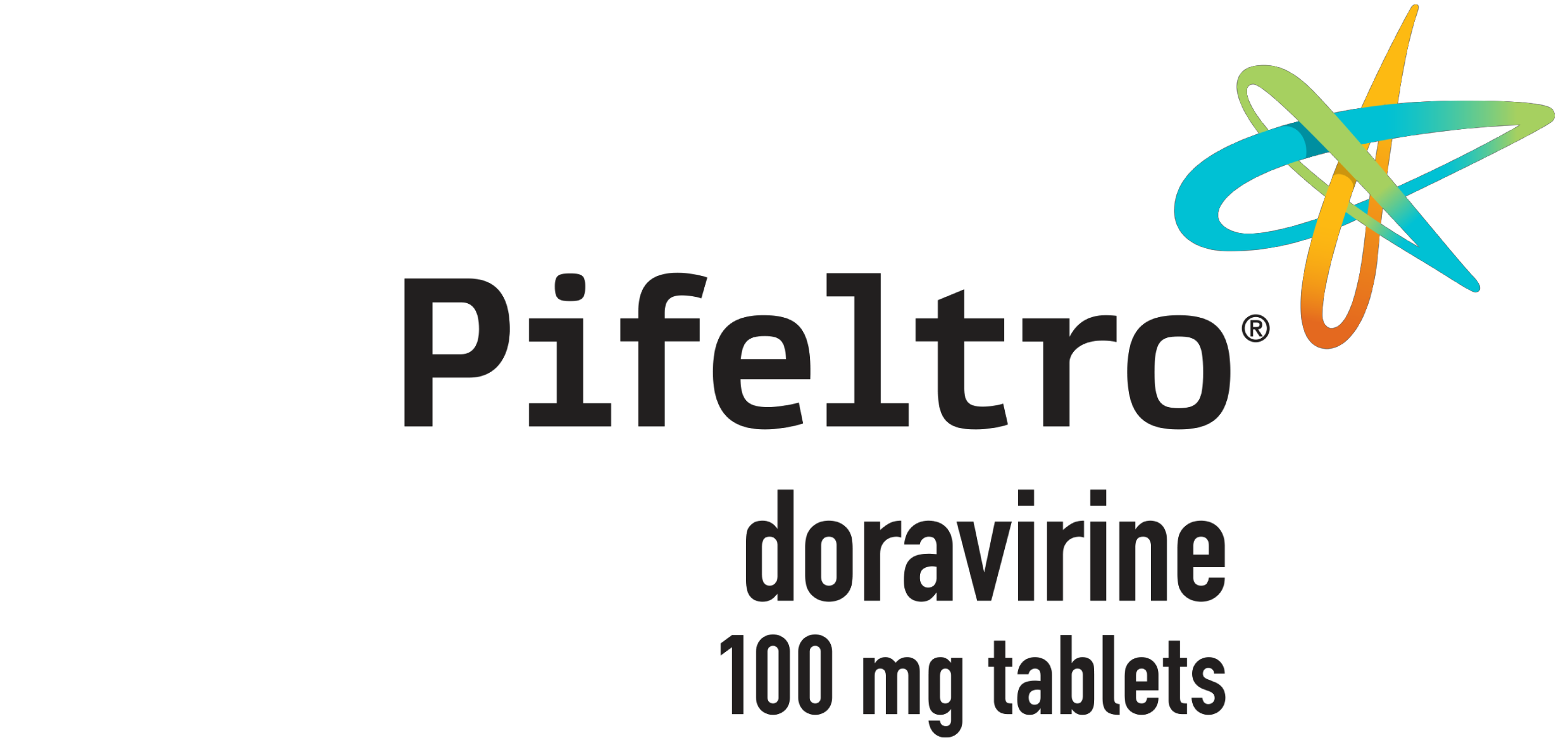Resistance profile of PIFELTRO® (doravirine)
Learn about:
DRIVE-SHIFT: In a 48-week study of virologically suppressed adults, which evaluated doravirine-based FDCa (n=656):
Zero cases of doravirine resistance in two participants in the Immediate Switch Group (ISG) at 48 weeks1
bProtocol-defined virologic failure is defined as two consecutive measurements of HIV-1 RNA ≥50 copies/mL at least one week apart.1
cNeither of the two participants developed detectable genotypic or phenotypic resistance to doravirine, lamivudine, or tenofovir during treatment with a doravirine-based FDC.
dThis participant developed the RT M184M/I substitution and phenotypic resistance to FTC and 3TC during treatment with their baseline regimen.
bProtocol-defined virologic failure is defined as two consecutive measurements of HIV-1 RNA ≥50 copies/mL at least one week apart.1
cNeither of the two participants developed detectable genotypic or phenotypic resistance to doraviririne, lamivudine, or tenofovir during treatment with a doravirine-based FDC.
dThis participant developed the RT M184M/I substitution and phenotypic resistance to FTC and 3TC during treatment with their baseline regimen.
DRIVE-SHIFT: 144-week extension phase evaluating doravirine-based FDC vs baseline regimen. In the 144-week extension phase (week 48 to week 144), there were:
Zero cases of resistance to doravirine in the four participants with samples available at 144 weeks2,3,e
fProtocol-defined virologic failure is defined as two consecutive measurements of HIV-1 RNA ≥50 copies/mL at least one week apart.2
fProtocol-defined virologic failure is defined as two consecutive measurements of HIV-1 RNA ≥50 copies/mL at least one week apart.2
Limitation: No formal statistics testing was planned for this updated analysis and, therefore, no statistical conclusions can be drawn.
DRIVE-FORWARD and DRIVE-AHEAD: Two studies of treatment-naïve adults (n=747) demonstrated a:
Low rate of resistance across clinical trials
Of the 36 participants in the resistance analysis subset, 10 participants (28%) developed genotypic and/or phenotypic resistance to the other drugs (abacavir, emtricitabine, lamivudine, or tenofovir) in the regimens of the DRIVE-FORWARD and DRIVE-AHEAD trials.
In the DRV/r treatment arm of DRIVE-FORWARD (n=383) through week 96, no participants showed the emergence of darunavir resistance-associated substitutions among 15 participants with resistance data and 2 of the participants had emergent genotypic or phenotypic resistance to lamivudine or tenofovir.
In the EFV/FTC/TDF treatment arm of DRIVE-AHEAD (n=364) through week 96, 15 participants showed the emergence of efavirenz resistance-associated substitutions among 25 (60%) participants in the resistance analysis subset and genotypic resistance to emtricitabine or tenofovir developed in 5 evaluable participants; emergent resistance-associated substitutions were RT K65R (n=1), D67G/K70E (n=1), L74V/V75M/V118I (n=1), M184I or V (n=5), and K219K/E (n=1).
gThere were 36 participants in the resistance analysis subset (HIV-1 RNA >400 copies per mL at virologic failure or early study discontinuation and having post-baseline resistance samples) from the doravirine treatment arms of 2 clinical trials evaluating a doravirine-based regimen (N=747) through week 96.
hMost participants had at least a 100-fold reduction in doravirine susceptibility.
iParticipants had only amino acid mixtures of NNRTI resistance substitutions.
jDoravirine-based FDC (fixed-dose combination) = doravirine 100 mg/lamivudine 300 mg/tenofovir disoproxil fumarate 300 mg tablets.
View DRIVE-FORWARD study design
Study designs
DRIVE-SHIFT study design
A randomized, multicenter, active-controlled, non-inferiority, open-label, phase 3 trial of adult participants with virologically suppressed HIV-1 for ≥6 months on 2 NRTIs with a PI plus either ritonavir or cobicistat, elvitegravir plus cobicistat, or an NNRTI, with no history of virologic failure. Participants were either immediately switched to a doravirine-based FDC (100 mg DOR/300 mg 3TC/300 mg TDF) on day 1 of the 48-week trial (Immediate Switch Group [ISG; n=447]) or continued their baseline regimen and switched after 24 weeks (Delayed Switch Group [DSG; n=223]) to a doravirine-based FDC.1,2
Extension study: Participants who completed the 48-week visit were eligible to continue receiving an open-label doravirine-based FDC for an additional 96 weeks, up to week 144.1,2
Primary efficacy end point: Percentage of participants with HIV-1 RNA ≥50 copies/mL in the ISG at week 48 vs the DSG at week 24: 2% for the doravirine-based FDC vs 1% for the baseline regimen. Difference (95% CI): 0.7 (-1.3, 2.6).1
Additional efficacy end point: Percentage of participants with HIV-1 RNA <50 copies/mL in the ISG at week 48 vs the DSG at week 24: 91% for the doravirine-based FDC vs 95% for the baseline regimen.1
Safety end point: For participants whose baseline regimen included a PI plus ritonavir: Mean change from baseline to week 24 in fasting LDL-C and non-HDL-C.1
DRIVE-FORWARD study design
A randomized, multicenter, double-blind, active-controlled, non-inferiority, phase 3 trial comparing PIFELTRO 100 mg once daily (n=383) vs darunavir 800 mg + ritonavir 100 mg once daily (n=383), each in combination with 2 NRTIs, FTC/TDF or ABC/3TC selected by the investigator, in treatment-naïve adult participants with HIV-1 RNA ≥1000 copies/mL.4,5
Primary efficacy end point: Percentage of participants with HIV-1 RNA <50 copies/mL at week 48 for PIFELTRO + 2 NRTIs vs DRV/r + 2 NRTIs: 84% vs 80%. Difference (95% CI): 3.9 (-1.6, 9.4).4
Secondary efficacy end point: Percentage of participants with HIV-1 RNA <50 copies/mL at week 96 for PIFELTRO + 2 NRTIs vs DRV/r + 2 NRTIs: 72% vs 65%. Difference (95% CI): 7.5 (1.0, 14.1).5
Safety end point: Mean change from baseline to week 48 in fasting LDL-C and non-HDL-C.4
DRIVE-AHEAD study design
A randomized, multicenter, double-blind, active-controlled, non-inferiority, phase 3 trial comparing a doravirine-based FDC (100 mg DOR/300 mg 3TC/300 mg TDF) once daily (n=364) vs 600 mg EFV/200 mg FTC/300 mg TDF once daily (n=364) in treatment-naïve adult participants with HIV-1 RNA ≥1000 copies/mL.6,7
Primary efficacy end point: Percentage of participants with HIV-1 RNA <50 copies/mL at week 48 for the doravirine-based FDC vs EFV/FTC/TDF: 84% vs 81%. Difference (95% CI): 3.5 (-2.0, 9.0).6
Secondary safety end point: Percentage of participants with HIV-1 RNA <50 copies/mL at week 96 for the doravirine-based FDC vs EFV/FTC/TDF: 77% vs 74%. Difference (95% CI): 3.8 (-2.4, 10.0).7
Primary safety end point: Percentage of participants with three pre-specified neuropsychiatric events (dizziness, sleep disorders/disturbances, and altered sensorium) at week 48.6,a,b
- Dizziness: 9% for doravirine-based FDC vs 37% for EFV/FTC/TDF. Difference (95% CI): -28.3 (-34.0, -22.5); P<0.001
- Sleep disorders and disturbancesc: 12% for doravirine-based FDC vs 26% for EFV/FTC/TDF. Difference (95% CI): -13.5 (-19.1, -7.9); P<0.001
- Altered sensoriumd: 4% for doravirine-based FDC vs 8% for EFV/FTC/TDF. Difference (95% CI): -3.8 (-7.6, -0.3); P=0.033
Safety end point: Mean change from baseline to week 48 in fasting LDL-C and non-HDL-C.6
an=364 for each treatment group.
bThe 95% CIs were calculated using Miettinen and Nurminen’s method.
cPredefined using MedDRA preferred terms, including: abnormal dreams, hyposomnia, initial insomnia, insomnia, nightmare, sleep disorder, and somnambulism.
dPredefined using MedDRA preferred terms, including: altered state of consciousness, lethargy, somnolence, and syncope.
Acronyms
3TC, lamivudine; ABC, abacavir; DOR, doravirine; DRV/r, darunavir/ritonavir; EFV, efavirenz; FDC, fixed-dose combination; FTC, emtricitabine; HDL-C, high-density lipoprotein-cholesterol; LDL-C, low-density lipoprotein-cholesterol; MedDRA, Medical Dictionary for Regulatory Activities; NNRTI, non-nucleoside reverse transcriptase inhibitors; NRTI, nucleoside reverse transcriptase inhibitors; PI, protease inhibitor; RNA, ribonucleic acid; RT, reverse transcriptase; TDF, tenofovir disoproxil fumarate.
References
- Johnson M, Kumar P, Molina JM, et al; for the DRIVE-SHIFT Study Group. Switching to doravirine/lamivudine/tenofovir disoproxil fumarate (DOR/3TC/TDF) maintains HIV-1 virologic suppression through 48 weeks: results of the DRIVE-SHIFT trial. J Acquir Immune Defic Syndr. 2019;81(4):463-472. doi:10.1097/QAI.0000000000002056.
- Kumar P, Johnson M, Molina JM, et al; for the DRIVE-SHIFT Study Group. Switching to DOR/3TC/TDF maintains HIV-1 virologic suppression through week 144 in the DRIVE-SHIFT Trial. J Acquir Immune Defic Syndr. 2021;87(2):801- 805. doi:10.1097/QAI.0000000000002642.
- Data available on request from the Merck National Service Center via email at daprequests@merck.com. Please specify information package US-DOV-01680.
- Molina JM, Squires K, Sax PE, et al; for the DRIVE-FORWARD Study Group. Doravirine versus ritonavir-boosted darunavir in antiretroviral-naive adults with HIV-1 (DRIVE-FORWARD): 48-week results of a randomised, double-blind, phase 3, non-inferiority trial. Lancet HIV. 2018;5(5):e211-e220. Epub 2018 Mar 25. doi: 10.1016/S2352-3018(18)30021-3.
- Molina JM, Squires K, Sax PE, et al; for the DRIVE-FORWARD Trial Group. Doravirine versus ritonavir-boosted darunavir in antiretroviral-naive adults with HIV-1 (DRIVE-FORWARD): 96-week results of a randomised, double-blind, non-inferiority, phase 3 trial. Lancet HIV. 2020;7(1):e16-e26. Epub 2019 Nov 15. doi: 10.1016/S2352-3018(19)30336-4.
- Orkin C, Squires KE, Molina JM, et al; for the DRIVE-AHEAD Study Group. Doravirine/lamivudine/tenofovir disoproxil fumarate is non-inferior to efavirenz/emtricitabine/tenofovir disoproxil fumarate in treatment-naive adults with human immunodeficiency virus-1 infection: week 48 results of the DRIVE-AHEAD trial. Clin Infect Dis. 2019;68(4):535-544. doi: 10.1093/cid/ciy540.
- Orkin C, Squires KE, Molina JM, et al. Doravirine/lamivudine/tenofovir disoproxil fumarate (TDF) versus efavirenz/emtricitabine/TDF in treatment-naive adults with human immunodeficiency virus type 1 infection: week 96 results of the randomized, double-blind, phase 3 DRIVE-AHEAD noninferiority trial. Clin Infect Dis. 2021;73(1):33-42. doi: 10.1093/cid/ciaa822.


